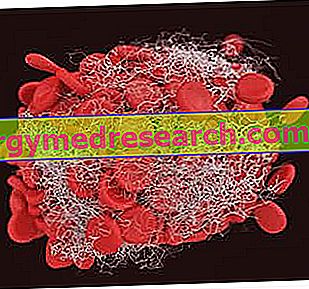Generality
Ischemia is the word that, in medicine, identifies any decrease or suppression of blood supply in a body district.

Figure: blood clot, called thrombus
Blood supplies the body's tissues and organs with oxygen and nutrients, which are vital elements. Therefore, a reduced or completely absent blood supply leads to the death (called necrosis) of the anatomical districts affected by the ischemic event.
The most frequent causes of ischemia include embolism or thrombosis and traumatic events.
The symptoms of ischemia depend on the organ or tissue involved. This means, for example, that a cardiac ischemia shows a different symptomatology, compared to a cerebral ischemia.
In the case of ischemia, there is a greater chance of survival and functional recovery if treatment is timely.
What is ischemia
Ischemia is the medical term that indicates any reduction in the flow of blood in a certain tissue or organ, such as to cause a decrease in the supply of oxygen and nutrients.
Oxygen and nutrients are fundamental elements for the survival of the cells constituting the organism. In fact, their prolonged lack (due for example to a failed therapeutic intervention) has irreversible consequences: it involves the death (or necrosis ) of the tissues and / or organs involved.
Ischemia is a vascular disease that mainly affects the arteries.
ISCHEMIA: WHICH MORE ORGANS YOU HIT?
Any part of the body can suffer from ischemia.
However, there are organs more at risk than others and which, once hit, can lead to serious consequences.
The organs in question are: the heart ( ischemic heart disease, myocardial ischemia or cardiac ischemia ), the brain ( cerebral ischemia ), the intestine ( intestinal ischemia ), the fingers and toes ( peripheral ischemia ).
Given the higher frequency of ischemic phenomena in these anatomical districts, in the next chapters we will tend to refer often to the aforementioned ischemia conditions.
Causes
Usually, to cause an ischemia, it is an obstruction inside one or more arterial vessels, an obstruction that involves a reduced blood supply of the tissues or organs supplied by the aforementioned arteries.
In most cases, obstruction is the result of embolism or thrombosis or traumatic events .
Embolism or thrombosis phenomena are typically associated with myocardial ischemia, stroke and intestinal ischemia; traumatic events, on the other hand, are usually related to the appearance of peripheral ischaemia at the level of the fingers or toes.
Thrombosis and embolism: what are they in short?
The term thrombosis indicates the presence of a blood clot, called thrombus, on the inner wall of an arterial or venous blood vessel.
The term embolism, on the other hand, identifies the presence, in the blood (therefore in the vessels), of a mobile body of blood or non-sanguine origin, which takes the specific name of embolus.
If large, the thrombi, as well as emboli, can obstruct the blood vessels.
RISK FACTORS
So many conditions favor the appearance of an ischemia.
Among the most important risk factors deserve special mention:
- Atrial fibrillation . It is an arrhythmia, that is an alteration of the heart rhythm.
- Cardiomyopathies . They are pathologies of the heart muscle, in the presence of which the heart functions inadequately.
- Coronary heart disease . They are diseases of the coronary arteries.
- Mitral valve diseases . The mitral valve is a valve of the heart.
- Diabetes
- hypertension
- Hypotension due to septic shock or heart failure
- arteriosclerosis
- atherosclerosis
- Hypercholesterolemia or the presence of high amounts of triglycerides
- Hypoglycemia. It is when blood glucose levels are lower than normal.
- Advanced age
- Overweight and obesity
- Physical inactivity
- Cigarette smoke
- Venous thromboembolism
- Peripheral arteriopathy
- Sickle cell anemia
- Thoracic outlet syndrome
- The compression of blood vessels, caused by the presence of tumors (mass effect)
- Exposure of the limbs to excessive cold or improper use of cryotherapy combined with the application of elastic bandages
- The severe rupture of numerous blood vessels
- Aneurysm rupture
ACUTE ISCHEMIA AND CHRONIC ISCHEMIA
An ischemia can occur in acute or chronic form.
What distinguishes the acute form from the chronic form is the fact that, in the first, the reduction of the blood flow is sudden and sudden, while, in the second, the same process takes place gradually.
For the speed with which it is established and with which it gives rise to complications, acute ischemia represents a medical emergency to be treated with the utmost timeliness.
Symptoms and Complications
The symptoms and signs of ischemia vary depending on the tissues or organs concerned.
This means that cardiac ischemia will present a different symptomatic picture from that of a cerebral ischemia or a peripheral ischemia.
In the human body, there are organs and tissues that suffer most due to a reduction in the blood supply to their cells. The heart, the brain and the kidneys are some examples of organs particularly sensitive to the lack of oxygen and nutrients: in fact, already after 3-4 minutes, they develop irreversible damage (necrosis). On the other hand, all the tissues and organs that have a slow metabolism show the first irreversible consequences after about 20 minutes .
Unfortunately, some cases of ischemia are asymptomatic, ie they lack symptomatology. Such situations can be very dangerous, as those who are victims of it do not notice what is happening to them and do not turn to relief efforts with due timeliness.
ISCHEMIC CARDIOPATHY (OR ISCHEMIA OF MYOCARDIUM OR CARDIAC ISCHEMIA)
The term myocardial ischemia encompasses two fairly common pathological conditions, known as angina pectoris and myocardial infarction, in which a discrepancy occurs between consumption and oxygen supply to the myocardium.
In angina pectoris, the ischemic process is temporary / reversible and does not cause permanent damage.
In contrast, in myocardial infarction - also known as a heart attack - ischemia is protracted and has irreversible consequences at the level of the myocardium (myocardial necrosis ).
Clearly, from the point of view of gravity, there is a substantial difference between the two conditions: angina pectoris is the signal of a minor cardiac suffering, compared to myocardial infarction.
The symptoms of angina pectoris and heart attack are very similar, almost overlapping; what changes is their duration.
The most common symptomatology consists of:
- Pain or pressure in the chest.
- Pain that, from the chest, can radiate to the back, arm, shoulder, neck, jaw or stomach.
- Dyspnea, ie shortness of breath.
- Nausea with or without vomiting.
- Limitations of physical ability. For example, the patient feels tired after any effort, even minimal.
- Palpitations or irregular heart rhythm (arrhythmias).
- Profuse sweating.
CEREBRAL ISCHEMIA
Cerebral ischemia is the pathological process from which the famous TIA ( Transient Ischemic Attack ) and ischemic stroke can result.
A TIA (also known as a mini-stroke) is a temporary interruption of blood flow in the brain, whose symptoms last less than 24 hours, without permanent consequences.
An ischemic stroke, on the other hand, is a prolonged interruption of cerebral blood flow, which causes symptoms lasting longer than 24 hours and a series of irreversible brain damage.
Although TIA and ischemic stroke are different in terms of gravity, they present a very similar symptomatology:
- Paralysis and numbness of the face and limbs.
- Difficulty walking, balance problems, coordination deficit and tendency to fall.
- Difficulty speaking and understanding.
- Visual difficulties (double vision, blurred vision, sudden blindness, etc.).
- Abnormal size of the pupil and lack of reactivity of the latter to light variations.
- Headache.
- Dizziness.
- Confusion.
- Memory deficit.
- Nausea with or without vomiting.
- Weakness.
- Changes in the state of consciousness.
The succession of so many mini-strokes and some particular ischemic strokes can determine a form of dementia, known as vascular dementia .
INTESTINAL ISCHEMIA

When the damage of intestinal ischemia is permanent and there is necrosis of the section of intestine involved, doctors speak more properly of intestinal infarction .
PERIPHERAL ISCHEMIA
Peripheral ischemia is generally an acute phenomenon. As such, it takes the second name of acute limb ischemia (or acute limb ischemia ).
The typical symptoms of acute limb ischemia are: pain, pallor, paresthesia, paralysis and loss of normal thermoregulation ( poichilotermia ).
WHEN TO REFER TO URGENT DOCTOR?
The most severe forms of ischemia require immediate medical intervention, as the patient's survival is at risk.
Doctors believe that some symptoms are more indicative of severe ischemia. For example, consider a sign of extreme danger:
- Vomiting or diarrhea with blood
- Unbearable abdominal pain
- Limb paralysis
- Dyspnea at rest
- The obvious changes in visual abilities
- The strong pain in the chest, as well as the strong sense of pressure
- The inability to speak or understand
- Alterations in the state of consciousness.
Diagnosis
In general, the diagnostic procedure for the detection of an ischemia starts from the objective examination of the symptoms. Subsequently, it continues with a series of instrumental procedures specific to the organ or tissues, which the doctor considers involved during the ischemic event.
The sooner an episode of ischemia is diagnosed, the greater the chances, through adequate care, of recovering the functionality of the tissues or organs concerned.
AN EXAMPLE: ISCHEMIC HEART DIAGNOSIS
In the case of a suspected ischemic heart disease, the doctor prescribes the execution of an electrocardiogram and blood analysis, aimed at finding specific markers of cardiac damage.
If these controls are insufficient or if there is a need to further investigate the situation, it could also prescribe an echocardiogram, a chest X-ray and a coronary angiography .
Treatment
In the event of any ischemia, the goal of therapy is to restore blood flow to the affected organs and tissues, so as to avoid possible (or further) permanent damage.
The treatments depend on the site of the ischemia and the causes that determined it (the presence of an embolus requires a treatment different from a traumatic lesion or a compression of the vessels due to a tumor).
What is essential, during the treatment of an ischemia, is the continuous monitoring of the patient by doctors and health personnel. In fact, as long as the patient's condition is still uncertain, it is impossible to consider the latter completely out of danger.
TREATMENTS FOR THE RECOVERY OF THE BLOOD FLOW
Some common treatments for restoring blood flow in the affected tissues or organs are:
- Angioplasty, a procedure that eliminates possible narrowing inside a blood vessel.
- Arterial revascularization . It consists of arterial bypass surgery . An arterial bypass operation involves the creation, by the surgeon, of an alternative route to the passage of blood; this alternative route has the purpose of eluding the obstacle that occludes the original arterial pathway. The most well-known arterial bypass surgery is coronary bypass, but readers are reminded that there is also bypass of the arteries of the lower limbs.
- Arteriotomy, a surgical procedure whereby the operating doctor eliminates emboli or thrombi. It involves the incision of the affected arteries.
- The administration of thrombolytic drugs, for the dissolution of blood clots.
SYMPTOMATIC TREATMENTS
Some episodes of ischemia also lend themselves to some symptomatic treatments, ie those treatments aimed at improving the symptomatic picture.
Examples of symptomatic treatments are: pain medication (to control pain), vasodilator drugs (to increase the caliber of blood vessels), medicines to reduce the workload of the heart (calcium channel blockers, ACE inhibitors, nitrates and beta-blockers) and oxygen therapy .
PREVENTIVE TREATMENTS
Patients with an ischemia following embolism or thrombosis are often predisposed to relapse .
To reduce this predisposition, doctors prescribe to patients a long-term anticoagulant therapy, based on the administration of drugs such as warfarin or heparin, and an antiplatelet therapy, which involves the administration of antiplatelet agents such as aspirin .
DRASTIC TREATMENT: AMPUTATION
The forms of severe peripheral ischemia require drastic surgery and permanent consequences, such as amputation of the affected limb .
In such situations, a dry or wet gangrene process induced by the ischemic process motivates amputation.
In medicine, the term gangrene (or gangrene) indicates a pathological condition characterized by the massive putrefaction of one or more tissues of the body.
Gangrene requires immediate medical intervention to prevent it spreading to adjacent healthy tissues. This explains the reason for the amputation: the latter, in fact, represents the only way to stop the process of spreading gangrene itself.
Prognosis
The prognosis of an ischemia depends on at least three factors:
- From the causes .
- From the features of ischemia itself . An ischemic event that causes a TIA is less severe and has a better prognosis than an ischemic event that causes a (ischemic) stroke.
- From the timeliness of care . Failure to treat an ischemia can have fatal consequences.



